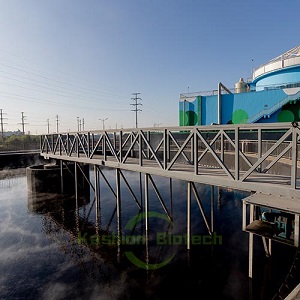
With the development of wastewater treatment process, the new nitrogen-containing wastewater treatment process based on the principle of anoxic denitrification has gradually entered people's vision, and has been more and more used in practical projects. The following factors often exist in the operation process, which affect the effect and cost of system operation: carbon source, dissolved oxygen concentration, pH, temperature, inlet water quality, etc. The following is a detailed analysis of these influencing factors, and provides possible solutions for your reference:

Carbon source
Influencing factors:
In the denitrification process needs a certain concentration of organic matter as the electron donor, generally uses the organic matter in the wastewater as the donor, but in practical application, the organic matter in the wastewater often can not meet the needs of the denitrification process;
Ideal parameters:
COD/TN for 3 to 5 or more;
Solutions:
Carbon sources are commonly used in waste water, such as methanol, sodium acetate and biomass carbon sources. It is necessary to select appropriate carbon sources according to the actual engineering situation.
Dissolved oxygen concentration
Influencing factors:
Denitrifying bacteria need to survive under anoxic conditions. If the dissolved oxygen in the reactor is too high, the dissolved oxygen reacts with organic matter preferentially as an electron acceptor, so the denitrification process must be carried out effectively under anaerobic or hypoxic conditions.
Ideal parameters:
DO concentration should be less than 0.5mg/L
Solutions:
Lower the stirring rate, lower the inlet dissolved oxygen, and switch to a reactor with better sealing.
pH
Influencing factors:
It is generally believed that pH can affect the concentration of FN and FNA in solution, thus affecting the process of nitrification reaction.
Ideal parameters:
For the growth of denitrifying bacteria, the optimum pH range was 6.5-8.
Solutions:
PH is adjusted by adding acid or base to water.
The temperature
Influencing factors:
Temperature has a significant effect on the denitrification process. For denitrification, when the temperature is below 15℃, the denitrification rate will decrease significantly.
Ideal parameters:
20-40 ℃;
Solutions:
When the temperature is too low, heat exchanger is added on the inlet pipe or circulating pipe, and steam heat exchange device is added in the reactor for heating.
The water quality
Influencing factors:
The conventional anoxic denitrification system can only treat the wastewater with low nitrate nitrogen content, and it is difficult to adapt to the wastewater containing toxic substances to microorganisms.
Ideal parameters:
Anoxic denitrification system has high adaptability and can treat wastewater with high nitrate nitrogen content and toxic substances.
Solutions:
(1) Through the pretreatment process, the concentration of influent nitrate nitrogen is reduced and the toxic substances are treated, but the corresponding construction and operation costs will increase;
(2) The anoxic denitrification system, such as ADFB anaerobic denitrification fluidization bed system, which has good adaptability to high concentration nitrate nitrogen wastewater and good adaptability to toxic substances, should be selected.
Name: Nicole Yu
Mobile:+86 17718148007
Tel:+86 17718148007
Whatsapp:8617718148007
Email:sales@kashionbiotech.com
Add:No.6, Zhanxi Road, Yaohai District, Hefei City, Anhui Province, China.